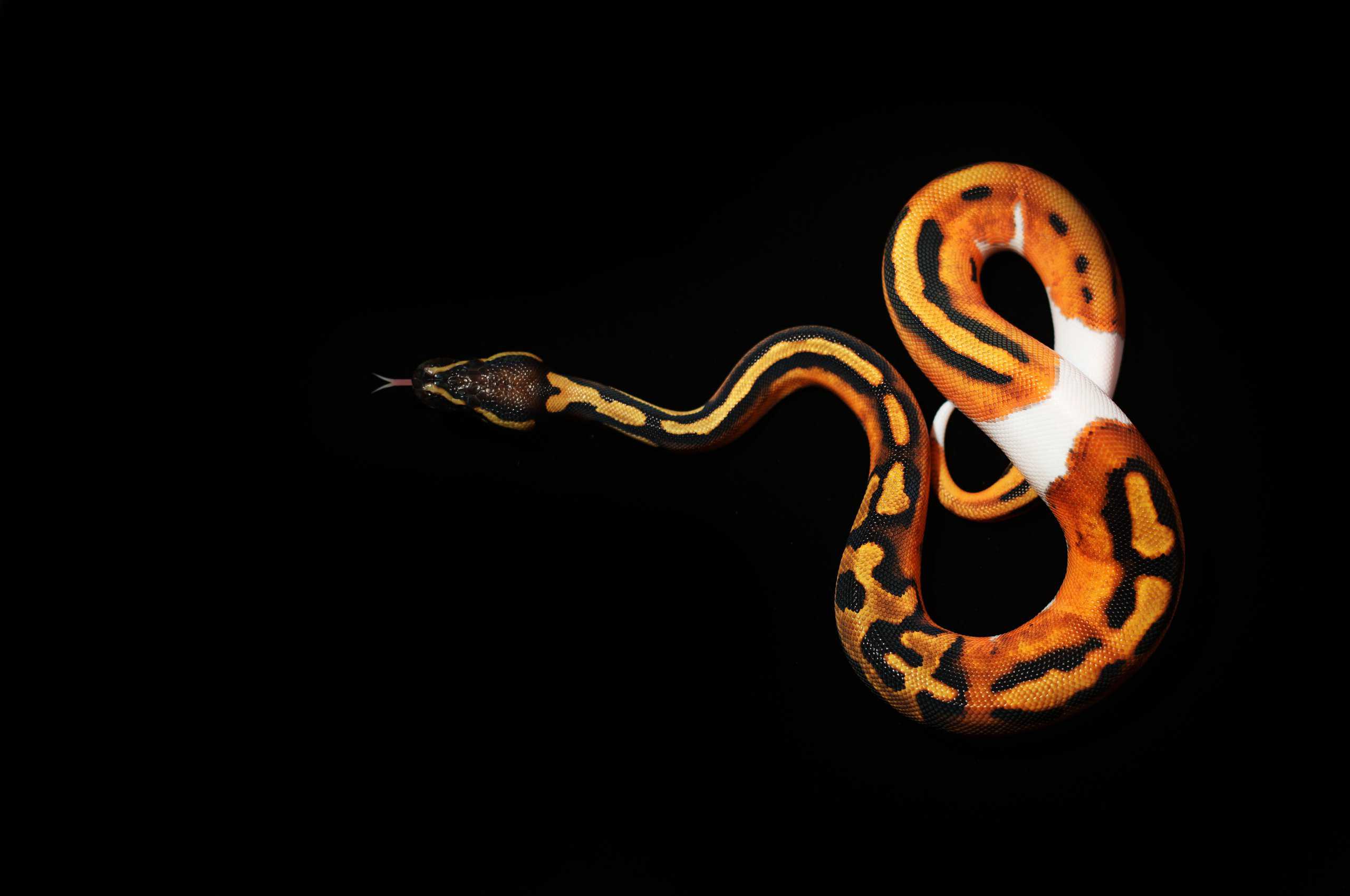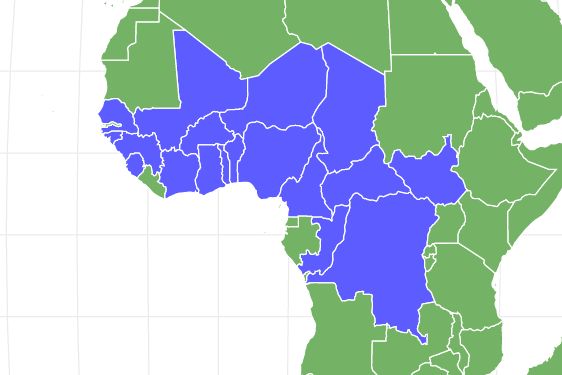Orange Dream Ball Python
Python regius
The "Orange Dream" name came from the idea that the morph would make its first breeder a million dollars.
Advertisement
Orange Dream Ball Python Scientific Classification
- Kingdom
- Animalia
- Phylum
- Chordata
- Class
- Reptilia
- Order
- Squamata
- Family
- Pythonidae
- Genus
- Python
- Scientific Name
- Python regius
Read our Complete Guide to Classification of Animals.
Orange Dream Ball Python Conservation Status
Orange Dream Ball Python Facts
- Prey
- Small rodents, birds, lizards
- Main Prey
- Rats and Mice
- Name Of Young
- Hatchling
- Group Behavior
- Solitary except during mating season
- Fun Fact
- The "Orange Dream" name came from the idea that the morph would make its first breeder a million dollars.
- Most Distinctive Feature
- Orange alien head markings
- Other Name(s)
- Royal python
- Incubation Period
- about 50-60 days
- Diet for this Fish
- Omnivore
- Lifestyle
- Nocturnal
- Crepuscular
- Location
- Western and central Africa
- Average Clutch Size
- 6
Orange Dream Ball Python Physical Characteristics
- Color
- Fawn
- Black
- Cream
- Orange
- Skin Type
- Scales
- Lifespan
- 20-30+ years
- Length
- 4-6 feet
- Age of Sexual Maturity
- 2-4 years
- Venomous
- No
- Aggression
- Low
View all of the Orange Dream Ball Python images!
The orange dream ball python is a popular color morph that started as a mutation.
These snakes have bright orange instead of brown markings with a white belly. One of the hundreds of color mutations in ball pythons, orange dream combines with others to create bright and beautiful color patterns.
3 Facts About The Orange Dream Ball Python
- The orange dream morph first appeared as a captive-hatched baby in 2002 and was later proven by Ozzy Boids in 2004.
- More than 3 million ball pythons have been exported from Africa since the 1970s.
- Ball pythons have more color and pattern morphs than any other reptile.

Scientific Name And Classification
Like all pythons, the orange dream ball python morph is part of the Pythonidae family of snakes. Their scientific name is Python regius, which means royal or kingly python. In many areas, ball pythons are also called royal pythons. In southeastern Nigeria, the Igbo people revere these snakes and believe them symbolic of the earth.
Evolution And History
The orange dream ball python is actually a newer mutation of the python that first appeared in 2002 and was further produced when it was bred with a Het albino male and resulted in additional offspring with the gene mutation. This gene, dubbed the orange dream gene, is accredited to Ozzy Boid. This gene-mutated python is part of the family of ball pythons that most likely evolved over 15 million years ago when the first fossil of a python was discovered.
Types Of
The orange dream ball python is one of about twenty-five known species in the Python genus. This species, like all pythons, are not venomous, but rather kills its prey by constriction. Here are a few of the python species:
Appearance And Behavior

Ball pythons have more color and pattern morphs than any other reptile.
©Keung/Shutterstock.com
Orange dream ball pythons are thick-bodied constrictors with triangular heads. They are harmless snakes that grow to be between four and six feet long. Like other ball pythons, these snakes have cryptic markings like alien heads along their sides and stripes going through their eyes and down to the jaw.
Even though they’re docile snakes, they have a mouth full of razor-sharp, rear-pointing teeth that help them grasp and swallow prey. Those who keep ball pythons typically experience the sharpness of their teeth at least once. These snakes have vertical pupils and usually very dark irises, except in some of the morphs with lighter eyes.
They’re fairly sedentary snakes, although they do enjoy exploring a well-setup enclosure. Ball pythons love clutter and the best enclosures reflect their natural habitat. As ambush predators, these snakes sit still and wait for their prey to wander too close. This species tends to roll up into a ball when they feel threatened, giving rise to its common name.
Morph Characteristics
The orange dream morph looks much like other ball pythons and has stripes visible through and under the eyes. It has alien head markings on the side of its body, except in this morph, the “eyes” are either missing or reduced. True to their name, the snake’s markings are pumpkin orange instead of brown, which stands out starkly against the black background. This morph’s belly is generally pearly white with almost no markings.
These morphs were first produced from a captive-hatched female that Ozzy Boids purchased in 2002 from Ian Gniazdowski at Outback Reptiles. A couple of years later, Ozzy paired that female with a het albino male. That pairing produced four eggs; two looked just like the mom with her orange markings.
The morph is popular with breeders in combination with others like the yellow belly and black pastel. It creates a whole set of new options for colors and patterns, a phenomenon explained by Ultimate Exotics in South Africa.
Pictures
Editor: These are links to images – shoot me a message if you have questions.
“Orange dream ball python morphs combine with others to make brighter patterns like this orange dream pied ball python.”
https://www.shutterstock.com/image-photo/orange-dream-pied-ball-python-beautiful-2050230884
“This spotnose fire orange dream ball python combines multiple mutations to create a unique animal.”
https://www.shutterstock.com/image-photo/orange-dream-spotnose-fire-ball-python-1664909731
“Fire orange dream het pied ball python: When a snake is “het” for a trait, it means that it likely carries the gene but doesn’t visually express it.”
https://www.shutterstock.com/image-photo/fire-orange-dream-het-pied-snake-2203154281
Habitat And Diet
Like many popular morphs, the orange dream ball python morph started out as a random mutation. While the egg was hatched in captivity, the snake’s mother was a wild ball python. This species lives in the savanna, grasslands, and open forested areas of Central and Western Africa. It’s primarily exported through Ghana, Benin, and Togo, but lives in over a dozen countries on the continent.
This species eats a variety of small prey in the wild, including rodents, nestling birds, and lizards. They happily eat rats, mice, and even day-old chicks in captivity.
Predators, Threats, Conservation, And Population

The orange dream morph isn’t a very large python and will hide in abandoned burrows to avoid prey.
©Deb Davis/Shutterstock.com
Ball pythons aren’t very big as pythons go, so they have several predators aside from people. Animals like various eagles, big cats, hyenas, and other predators take them as food. These snakes hide from them in abandoned burrows and termite mounds, but their cryptic pattern allows them to cruise through the undergrowth, almost invisible.
In the wild, the IUCN Redlist of Threatened species lists them as near threatened. Ball pythons they’re actively hunted for food and leather and used in traditional medicine. In addition to the damage done to the natural habitat by agricultural expansion and economic development, this has reduced their numbers. There are, however, a large number of them exported each year. Since the 1970s, over 3 million have been set overseas as pets. Some believe that all of these factors cause concern and that more needs to be done to monitor ball python populations in the wild in all locations.
Reproduction, Babies, And Lifespan

These pythons generally have a long lifespan, living between 20-30 years.
©Pavaphon Supanantananont/Shutterstock.com
Ball pythons and their morphs have a long lifespan when cared for properly. They generally live 20-30 years and, as adults, only need to eat about every 3-5 weeks.
This species matures at about 2-4 years, or when they become big enough. In the wild, females breed roughly every other year. It gives them time to recover body mass because of the physical stress of laying eggs and protecting them until hatching takes. However, in captivity, breeders take the eggs and incubate them artificially, which increases the number of eggs that hatch. It also gives them a chance to help the female replace weight loss because of breeding.
Similar Animals
View all 66 animals that start with OOrange Dream Ball Python FAQs (Frequently Asked Questions)
How are orange dream ball pythons different than others?
Mostly it’s their color – the browns and bronze of a typical wild pattern are replaced with pumpkin orange. The pattern is a little different too, but not overly.
How do orange dream ball pythons hunt?
They love to sit and wait for their food. As an ambush predator, they don’t usually hunt actively.
Where do orange dream ball pythons live?
Since they’re a natural mutation that a breeder took advantage of, there may only be a few random individuals in the wild. However, they’re common in the ball python pet trade.
What do orange dream ball pythons eat?
Like many snakes, orange dream ball pythons are rodent exterminators extraordinaire – they prefer rats and mice, but will take the occasional baby bird also.
Thank you for reading! Have some feedback for us? Contact the AZ Animals editorial team.
Sources
- D'Cruze, N., Wilms, T., Penner, J., Luiselli, L., Jallow, M., Segniagbeto, G., Niagate, B. & Schmitz, A. 2021. Python regius. The IUCN Red List of Threatened Species 2021: e.T177562A15340592. https://dx.doi.org/10.2305/IUCN.UK.2021-2.RLTS.T177562A15340592.en. Accessed on 22 August 2022., Available here: https://www.iucnredlist.org/species/177562/15340592
- Python regius | Reptarium Reptile Database, Available here: https://reptile-database.reptarium.cz/species?genus=Python&species=regius
- Ball python genetic traits | Morphopedia, Available here: https://www.morphmarket.com/morphpedia/ball-pythons/
















